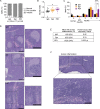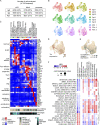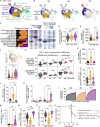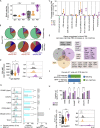Single-cell profiling reveals unique features of diabetogenic T cells in anti-PD-1-induced type 1 diabetes mice
- PMID: 37432393
- PMCID: PMC10336233
- DOI: 10.1084/jem.20221920
Single-cell profiling reveals unique features of diabetogenic T cells in anti-PD-1-induced type 1 diabetes mice
Abstract
Immune-related adverse events (irAEs) are a notable complication of PD-1 cancer immunotherapy. A better understanding of how these iatrogenic diseases compare with naturally arising autoimmune diseases is needed for treatment and monitoring of irAEs. We identified differences in anti-PD-1-induced type 1 diabetes (T1D) and spontaneous T1D in non-obese diabetic (NOD) mice by performing single-cell RNA-seq and TCR-seq on T cells from the pancreas, pancreas-draining lymph node (pLN), and blood of mice with PD-1-induced T1D or spontaneous T1D. In the pancreas, anti-PD-1 resulted in expansion of terminally exhausted/effector-like CD8+ T cells, an increase in T-bethi CD4+FoxP3- T cells, and a decrease in memory CD4+FoxP3- and CD8+ T cells in contrast to spontaneous T1D. Notably, anti-PD-1 caused increased TCR sharing between the pancreas and the periphery. Moreover, T cells in the blood of anti-PD-1-treated mice expressed markers that differed from spontaneous T1D, suggesting that the blood may provide a window to monitor irAEs rather than relying exclusively on the autoimmune target organ.
© 2023 Collier et al.
Conflict of interest statement
Disclosures: A.H. Sharpe reported grants from National Institutes of Health P01 AI56299, P01 AI39671, and P01 108545, and grants from Vertex during the conduct of the study. A.H. Sharpe reported personal fees from Surface Oncology, Sqz Biotech, Selecta, Elpiscience, Bicara, Fibrogen, Alixia, GlaxoSmith Kline, Janssen, and Amgen; “other” from Monopteros, IOME, and Corner Therapeutics; and grants from Merck, Roche, Ipsen, Novartis, Quark Ventures, AbbVie, Moderna, and Erasca outside the submitted work; in addition, A.H. Sharpe had a patent number 7,432,059 with royalties paid Roche, Merck, Bristol-Myers-Squibb, EMD-Serono, Boehringer-Ingelheim, AstraZeneca, Leica, Mayo Clinic, Dako, and Novartis; a patent number 7,722,868 with royalties paid Roche, Merck, Bristol-Myers-Squibb, EMD-Serono, Boehringer-Ingelheim, AstraZeneca, Leica, Mayo Clinic, Dako, and Novartis; a patent number 8,652,465 licensed “Roche”; a patent number 9,457,080 licensed “Roche”; a patent number 9,683,048 licensed “Novartis”; a patent number 9,815,898 licensed “Novartis”; a patent number 9,845,356 licensed “Novartis”; a patent number 10,202,454 licensed “Novartis”; a patent number 10,457,733 licensed “Novartis”; a patent number 9,580,684 issued “none”; a patent number 9,988,452 issued “none”; a patent number 10,370,446 issued “none”; a patent to 10,457,733 issued; a patent number 10,752,687 issued; a patent number 10,851,165 issued; and a patent number 10,934,353 issued. A.H. Sharpe is on the scientific advisory boards for the Massachusetts General Cancer Center, Program in Cellular and Molecular Medicine at Boston Children’s Hospital, the Human Oncology and Pathogenesis Program at Memorial Sloan Kettering Cancer Center, the Bloomberg-Kimmel Institute for Cancer Immunotherapy, the Gladstone Institute, and Bioentre. She is an academic editor for the
Figures











References
-
- Abdelsamed, H.A., Zebley C.C., Nguyen H., Rutishauser R.L., Fan Y., Ghoneim H.E., Crawford J.C., Alfei F., Alli S., Ribeiro S.P., et al. 2020. Beta cell-specific CD8+ T cells maintain stem cell memory-associated epigenetic programs during type 1 diabetes. Nat. Immunol. 21:578–587. 10.1038/s41590-020-0633-5 - DOI - PMC - PubMed
-
- Almutairi, A.R., McBride A., Slack M., Erstad B.L., and Abraham I.. 2020. Potential immune-related adverse events associated with monotherapy and combination therapy of Ipilimumab, Nivolumab, and Pembrolizumab for advanced melanoma: A systematic review and meta-analysis. Front. Oncol. 10:91. 10.3389/fonc.2020.00091 - DOI - PMC - PubMed
Publication types
MeSH terms
Substances
Grants and funding
LinkOut - more resources
Full Text Sources
Other Literature Sources
Medical
Molecular Biology Databases
Research Materials

